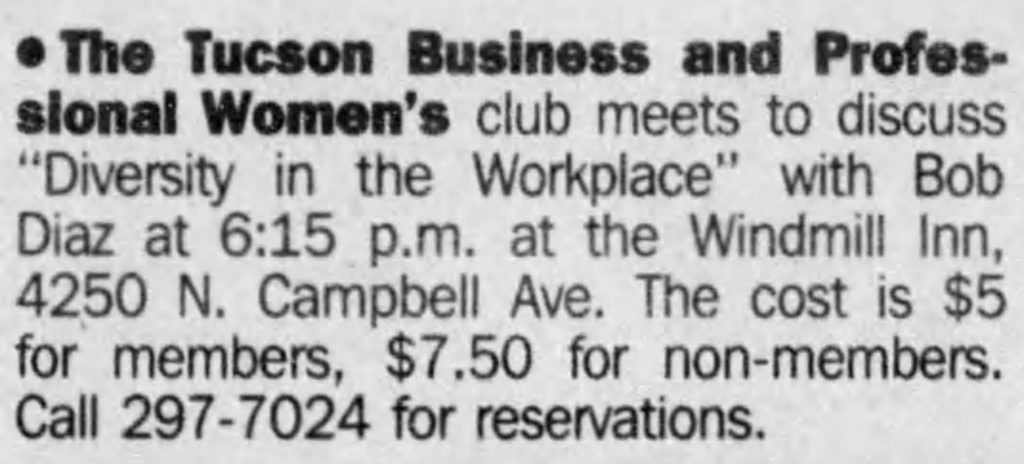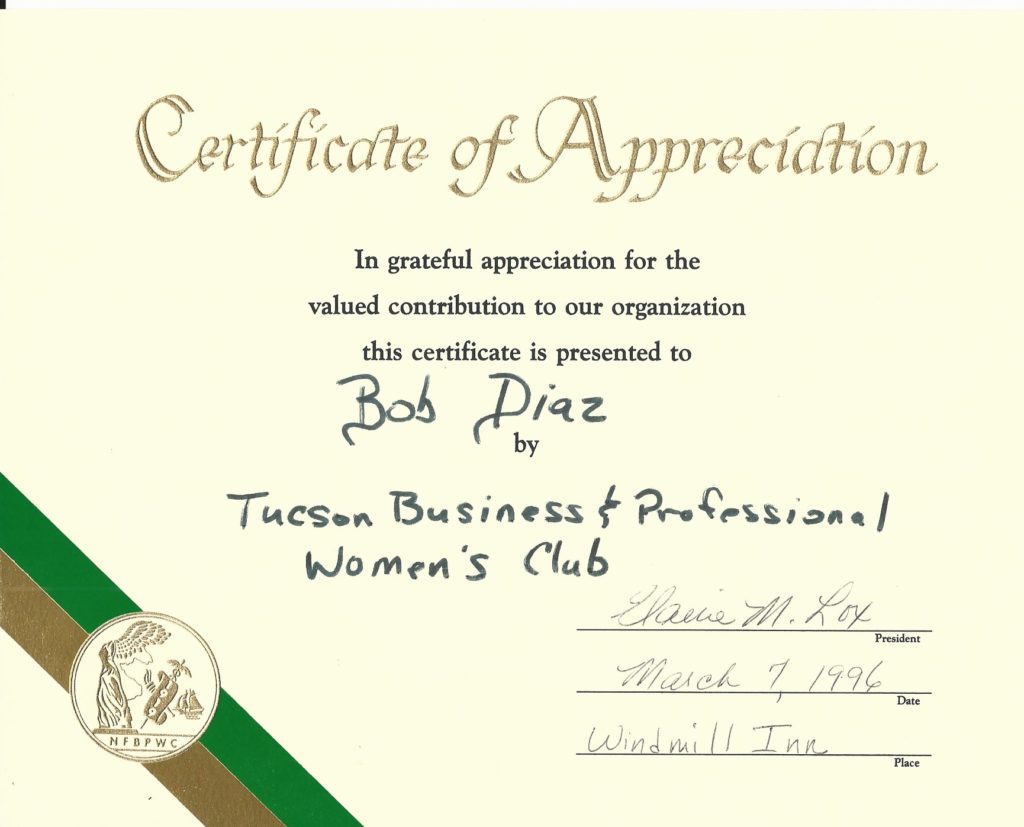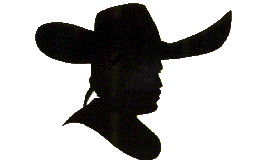I gave this presentation on enemy turf, so to speak. It felt like I had been thrown into a lion’s den and was about to get eaten alive at any moment. These ladies were not interested in hearing that the ability to speak Spanish and communicate with the Spanish-speaking was value-added and that it should be rewarded by increasing the pay of those who had this ability. In the end, however, I survived, and felt good that I did this presentation. I might have even convinced one or two of the attendees that having bilingual skills is indeed an asset when working with the public.

Diversity presentation
Introduction
Good evening. My name is Bob Diaz. Before I begin my presentation, I’d like to tell you a little bit about myself. I’m a Mexican American with roots here in southern Arizona that go way back, a native Tucsonan, and a graduate of the University of Arizona. I have a B.A. in Psychology and a masters degree in Library Science. I’m currently employed as Assistant to the Dean for Staff Development, Recruitment and Diversity at the University of Arizona Library. Prior to that, I was an associate reference and instruction librarian at the University of Michigan Undergraduate Library from 1987- 1992. I’m very happy to be here tonight, and I hope we have a very useful and productive session.
I’ve been asked to discuss the issue of diversity in organizations. I will talk about three major issues: First I will ask the question, why bother with diversity anyway and will provide some context for what we are dealing with. Then I’ll discuss diversity within organizations, and use examples from my own experiences at the University of Arizona to illustrate some of the points I would like to make. Thirdly, I will discuss the issue of personal responsibility as it relates to understanding and embracing diversity. Finally, we’ll open up the floor to questions and comments from you.
Just what is diversity and why are we bothering?
Is it about race, ethnicity, gender, sexual orientation, age?
Is it about individual differences not included in the above categories? Is it about affirmative action and equal employment opportunity? The answer is yes, yes, yes. In fact, there are a multitude of definitions. One organization defines diversity as: those human qualities or characteristics that make people different, unique, the same, and similar. These distinctions are not limited to race, gender, or ethnicity, according to this definition. Another definition is: diversity is any difference that makes a difference.
However, the focus of my presentation tonight will not be solely on “individual differences” or unique qualities or characteristics” but on racial, gender and ethnic diversity and what needs to be done within companies and organizations, as well as at the individual level to change the way things now stand. I’ve chosen this focus because race, gender and ethnicity are key factors in the diversity equation and have been throughout the history of this nation. While some people would argue that there are laws on the books that protect the rights of members of minority groups and women and that there is equal opportunity for every citizen, it is clear that we are not yet at the point where we can say there is a level playing field. White males still dominate our country’s major corporations, and are still clearly the ones that hold most, if not all of the power at all levels of government and society.
Here are some basic facts that will help further this discussion:
3 out of 10 Americans are persons of color. However, in less than 50 years, (some say sooner) one half of the U.S. population will be African American, Latino, Native American, or Asian American. This is now the case in California.
By the year 2000, nearly one half of the civilian workers in the U.S. will be female.
Women with college degrees earn roughly the same as men with high school diplomas.
Women earn 72 cents for every dollar a man earns for the same work.
In a study of 15 major corporations, one researcher found that minorities comprised less than 8% of middle management and only 2% of upper management positions.
There are many other well known documented facts that are important to know. For example,
Minorities have less access than non-minorities to quality education, good jobs, upward mobility, and representation in government, and have lower income levels and higher mortality rates than non minorities.
Historically, minorities have been viewed by the dominant culture as either the enemy (Asians and Native Americans) or as a source of cheap labor (Asians, Latinos, African Americans) and were treated badly by members of the dominant culture, receiving lower wages and fewer societal benefits. While we cannot go back and change history, what we can do is try to understand how we got to where we are now. It isn’t a matter of placing blame either. It’s a matter of putting these issues into context.
There is an increase in racial and ethnic violence in our society. Hate groups are on the rise. There is increased anti-immigrant sentiment and less tolerance for people who choose to continue to preserve their cultural traditions and languages.
What does all this point to?: change is taking place and, as always, there is resistance. In fact, one writer, has noted that “diversity was never the issue. Diversity is a fact. The question is about inclusion or exclusion of whom, on what terms, and for what purpose? The issue is about fear: our fear of the stranger, our shadow side, our fear of change, and our fear of failure.”
While the outlook for our society may seem bleak, it’s where we are. And we have to do something about it. We have to begin to learn about eachother and to work together to overcome our fear of one another. This has to take place at multiple levels: at the societal level, the corporate level and the individual level.
Before moving on to looking at what can be done in corporations and at the individual level, I’d like to make one other point.
For me personally, embracing diversity has always been akin to “doing the right thing”. Respect for all people and tolerance for difference are values I hold dear. However, the arguments or what some would call “the moral imperative” that provided fuel for the civil rights movement and much of the legislation that followed took us all only so far. In fact, some folks argue that the conditions for minorities in this country have worsened since the sixties.
What do we need to do to take us further? One writer argues that diversity is a bottom line issue, and indeed it is: if we don’t begin to include people of color and others outside the dominant culture in our institutions and corporations, they will go elsewhere, not only for employment but for products and services. And believe me the competition is there waiting to serve and to sell. A good example is the Honda corporation. It realizes that it has a diverse customer base here in the U.S., so it has done market studies to determine the needs of these customers and it has also hired people from these diverse communities to sell Honda’s products. Remember that these communities are increasing in numbers too. What does this mean? Think about it.
So, what needs to be done to begin to address diversity in a company or organization? First, there needs to be commitment at the top. In study after study, the data clearly shows that the role of top management in setting the direction and agenda for implementing diversity goals, programs, and training is critical. Top management needs to set the agenda for change. It must look at its mission and values statements and change them. It must begin to address it’s hiring and recruitment practices and look at retention and promotion issues, communication issues, supervisory practices, the services that are provided and how they are provided. Management must also encourage all of its employees to behave with respect both for their fellow employees and for their customers. Training needs to take place. But, changes will not occur overnight. It takes practice and patience to change an organizational culture.
At the University of Arizona Library, we have a very strong commitment from the top. Our Dean, Carla Stoffle, has written extensively on these issues and has really put her money where her mouth is. Our library has a very diverse workforce (in fact, we are far above the national average in terms of numbers of minorities at the professional level). We have also included diversity in our mission and values statements, in our team leader review process, in our job descriptions and in many of our team objectives. We have in place my position, which oversees the efforts of the Affirmative Action committee and the Library diversity council. We have provided our staff with many training and learning opportunities, and have even been rewarded for taking the lead on campus in the area of diversity. Many of our programs are both educational and celebratory. We’ve addressed such diverse issues as homophobia in the workplace, what it means to be Jewish in the U.S, we’ve had a Chinese New Year celebration, and we’ve sponsored programs for the entire campus on topics such as the role of women in Islam. We’ve also co-sponsored numerous events such as the recent visit by Harvard professor Cornell West. While it is clear that we have made lots of progress, there will always be more work to do. We are finding that in a team-based organization, meeting facilitation is a very important skill as it is key to fostering a environment where all staff are given a fair chance to communicate and participate in everyday meetings and events. We now are working on building these skills across the Library.
At the personal level, there are many things that can be done to understand and embrace diversity. First and foremost, I would encourage anyone to begin with a positive attitude. What an incredible opportunity this can be for learning and growth!! Begin by questioning your own assumptions about how you see the world. Question your generalizations and stereotypes (we all make them). Question what you see on television, and what you read in books and magazines. Read a book by a person of color. Read a book about diversity. Go to a local fiesta or pow wow. Tucson is a very unique and diverse community. Explore it. Challenge your friends to a discussion of race and ethnicity. Question your assumptions again and again.
I’ll leave you with one final quote from a book entitled The Diversity Advantage by John P. Fernandez and Mary Barr. “Although the U.S. possesses the best laws in all the world to protect all its citizens, it must move from the philosophical and legal to the proactive and personal. US citizens must, in short, walk their talk. Each individual must recognize that he or she is part of both the problem and the solution….Thank you very much.

